Mercedes R171 SLK-Class 2004 – 2010
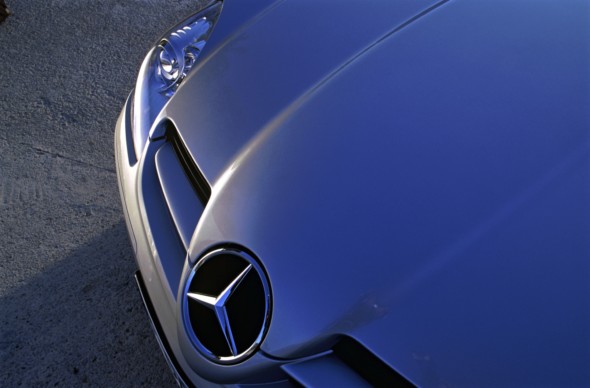

SLK-Class: The allure of the roadster summed up in three letters
- New generation of the leading compact roadster
- SLK driving pleasure powered by a new V6 and, for the first time ever, a V8
- Unique innovations like AIRSCARF, 7G-TRONIC and THERMOTRONIC
Over 308,000 delighted customers in every corner of the world, more than 40 international awards and a position as the global leader in its market segment give the outgoing SLK-Class an extremely impressive CV.
The Mercedes-Benz Roadster has been setting standards in its class since its arrival in autumn 1996 – not just by virtue of its ground-breaking technological prowess but also thanks to a rather differ-ent attribute: its emotional appeal.
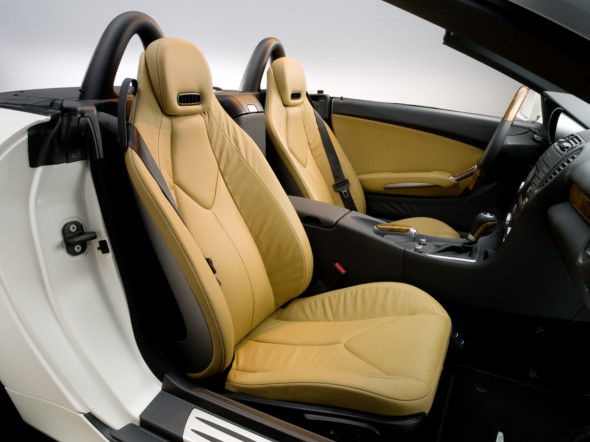
Eight years after the first SLK premiere, the second generation of the Roadster is set to take the world by storm in spring 2004. As stimulating, refreshing and potent as an Italian espresso, the new Roadster displays its sporting prowess in much stronger terms than the outgoing model.
Underpinning these enhanced performance credentials are the powerful new engines, a sporty suspension set-up, more direct steering and a precise six-speed manual transmission. Inspired by styling elements from the latest racing cars, the exterior design of the roadster continues the dynamic theme and identifies the SLK-Class as a fully-fledged member of the Mercedes-Benz sports-car family.
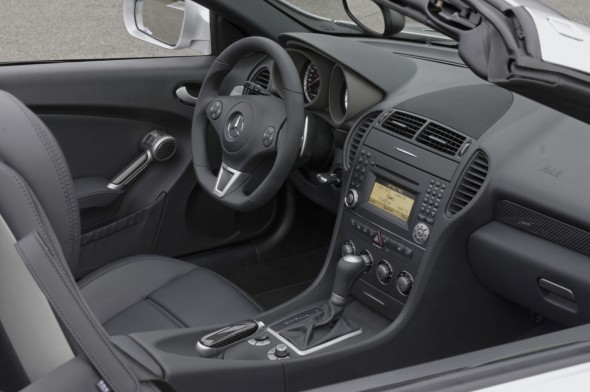
The Roadster also builds on the proven strengths of its predecessor – in the shape of a further developed, space-saving vario-roof, for example, even more innovative safety features and unique new systems such as AIRSCARF neck-level heating, bi-xenon headlamps with cornering light function and the 7G-TRONIC seven-speed automatic transmission for the SLK 350 (all optional).

These are the key ingredients in an impressively bold automotive character, one which Mercedes-Benz is using to write a new chapter in its long and illustrious history in roadster construction. Dynamism, emotional appeal and innovation are etched into the SLK design, making promises which the compact sports car goes on to keep through every kilometre of every journey.
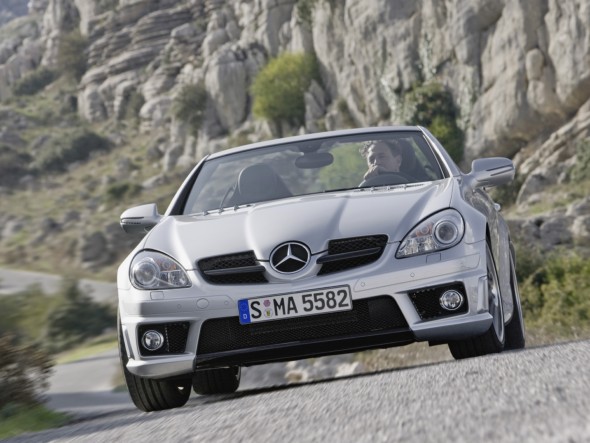
Three variants of the SLK-Class will be available from European Mercedes-Benz sales and service outlets and dealerships from the end of March 2004. With its TWINPULSE four-cylinder engine, the SLK 200 KOMPRESSOR combines impressive power with exemplary economy. Both faster and developing more torque than the outgoing model with the same output, it uses around eight percent less fuel. However, the new sports Roadster offers a lot more in terms of its agility, high-class looks and feel, comfort and range of standard equipment, which includes the following features:
- Stowage box on rear bulkhead
- Luggage net in passenger footwell and on rear bulkhead (driver’s side)
- Adaptive airbags
- Heated and electrically adjustable ex-terior mirrors
- Outside temperature display
- Occupancy sensor in passenger seat upholstery
- ESP® with anti-lock braking system, acceleration skid control and Brake Assist
- Headlamp Assist
- Folding seat backrests
- Two-stage belt force limiters
- Belt tensioners
- Head/thorax side airbags
- Remote boot lid opening via key
- Automatic heating system with dust filter and separate temperature control
- Automatic child seat recognition
- Light-alloy wheels: 7 J x 16
- Multifunction steering wheel, leather
- Projection-type headlamps
- LED tail lights and brake lights
- Six-speed manual transmission
- Manual seat height adjustment
- Silver-coloured sports gearshift lever
- Sports seats with magnesium frame
- Cruise control with SPEEDTRONIC
- Roll-over bars for driver and passen-ger
- Vario-roof with heated rear window
- Fabric draught-stop
- Central display in the instrument clus-ter with trip computer
- Central locking
- Silver-coloured trim elements
The new SLK 350 offers everything that you would expect from a full-blooded sports roadster: spirit, poise and undiluted driving pleasure. Under the bonnet, the newly developed six-cylinder engine gives the SLK a particularly powerful heartbeat, one which sets the driver’s pulse racing the second the key is turned. The technical make-up and equipment features of the SLK 350 are a reflection of the performance-based character of this model variant. The V6 model comes with the following items of standard equipment not included in the SLK 200 KOMPRESSOR:
- 17-inch light-alloy wheels in five-spoke design
- Enlarged brakes with perforated front brake discs
- Interior lighting package
- Mixed-size tyres (front: 225/45 R 17, rear: 245/40 R 17)
- THERMATIC air conditioning
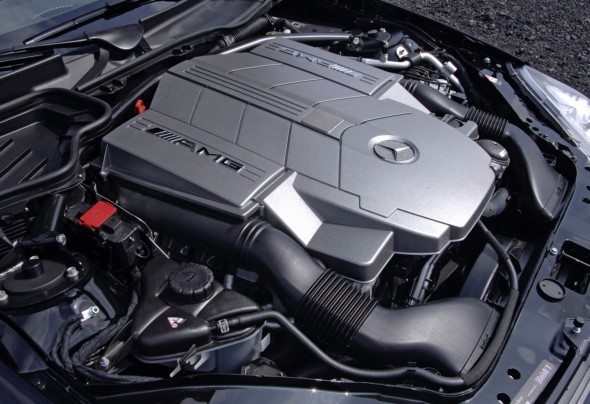
With the SLK 55 AMG, the second generation of the Mercedes compact Roadster has produced a car which gives even the sports car elite a run for their money. No other model in this vehicle class can compete with the 265-kW/360-hp output and 510 Newton metres of torque generated by the top-of-the-range SLK. The V8 engine at the source of this prodigious power also has the distinction of being the only eight-cylinder unit available in this market segment. The standard equipment package for the AMG model is equally as exclusive, and includes the following items not offered in the SLK 200 KOMPRESSOR:
- 18-inch Mercedes-AMG light-alloy wheels in multi-spoke design
- 7G-TRONIC seven-speed automatic transmission with AMG-SPEEDSHIFT and steering-wheel gearshift buttons
- AMG bodystyling with special front apron and spoiler lip on the boot lid
- AMG sports seats
- AMG sports suspension
- High-performance braking system with perforated composite brake discs at front
- Interior lighting package
- Mercedes-AMG ergonomic sports steering wheel
- Mixed-size tyres (front: 225/40 R 18, rear: 245/35 R 18)
- Nappa leather upholstery
- Seat heating
- Stainless steel door sills
- THERMATIC air conditioning
New technical developments and innovations from luxury-class Mercedes-Benz models are available as options for the SLK, further improving comfort and active safety and enhancing the value of the sports Roadster. The range includes:
- Audio 20 CD with nine speakers
- Audio 50 APS radio with CD navigation system
- Bi-Xenon headlamps with cornering light function and headlamp cleaning system
- COMAND APS with DVD navigation function, integrated radio and DVD drive
- PARKTRONIC parking assistance system
- Infrared remote control for the vario-roof
- THERMATIC air conditioning (for SLK 200 KOMPRESSOR)
- THERMOTRONIC luxury automatic climate control
- AIRSCARF neck-level heating for driver’s and passenger’s seats
- Leather upholstery (for SLK 200 KOMPRESSOR and SLK 350)
- Nappa leather upholstery in tobacco brown (for SLK 200 KOMPRESSOR and SLK 350)
- Heated steering wheel
- Steering-wheel gearshift buttons (for automatic transmission)
- Speed-sensitive steering
- Rain sensor
- Tyres with run-flat system
- Tyre pressure loss warning system
- 7G-TRONIC seven-speed automatic transmission (for SLK 350)
- Sound system (380 watts) with surround sound and eleven speakers
- Sports suspension (for SLK 200 KOMPRESSOR and SLK 350)
- Fine-wood trim (for SLK 200 KOMPRESSOR and SLK 350)
Design: love at first sight
The new SLK-Class by Mercedes-Benz is an automobile that was primarily designed from the heart. The lines of this roadster bear the signature of talented and enthusiastic designers of both sexes who have defined its character by stylishly combining technology with aesthetics and function with emotion.
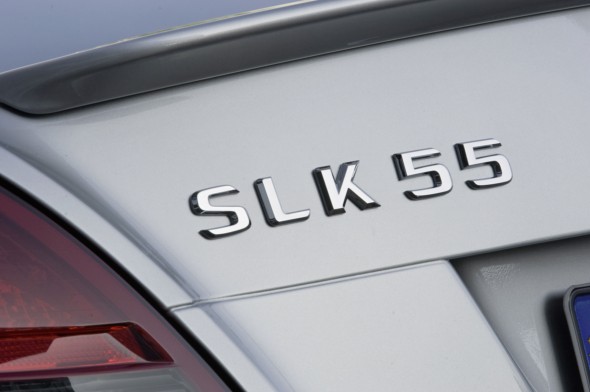
This is already shown by the first sketches with which they lent expression to their ideas. These present the SLK as a powerful sports car with large wheels, muscular shoulders and a dynamic wedge shape. The new two-seater was to be given more masculine lines than the preceding model, and show at first glance that it is more powerful – but also that it has grown up.

The front end plays an important part in the implementation of this concept. It symbolises sporty attributes such as power and performance by means of a long bonnet with a wide, slightly raised central axis, which tapers towards the striking front section and gives the Roadster a new but familiar face.
In this way the SLK-Class echoes a stylistic feature of the successful Mercedes Silver Arrows from Formula 1, while demonstrating unmistakably that it possesses the genes of the legendary Mercedes racing sports cars.
The large headlamps likewise provide an unmistakable emphasis, both by day and by night: during daylight the highly polished surfaces reflect sunlight to make the lighting units sparkle like precious gems, and at night the state-of-the-art projection lamps characterise the lighting concept of the SLK-Class and show that the sophisticated design is backed up by equally sophisticated technology.

The new SLK-Class also shows its unmistakable character when viewed from the side: a long bonnet, wide doors and a short rear end – these are the typical features of a sports roadster, and they are even more prominent in this case.
This is partly because the wheelbase is 30 mm longer and the body 72 mm wider than in the preceding model. These new dimensions emphasise the powerful proportions typical of a road-ster. Owing to the extremely short front and rear overhangs, the gaze is focused on two very important features of a sports car, namely the wheels.
The 16-inch wheels underline the muscular, and active nature of the new SLK-Class when viewed from the side. Widely flared wings extend around the well-filled wheel arches like perfectly tones muscles, symbolising the athletic power of this roadster.
The body language is clear: in these areas the metal skin is intentionally tailored to be rather tight and “body-conscious”, with pronounced curves that arouse curiosity about the muscles concealed beneath it. This impression is even more striking in the six-cylinder SLK 350, as Mercedes-Benz uses 17-inch wheels as standard here.
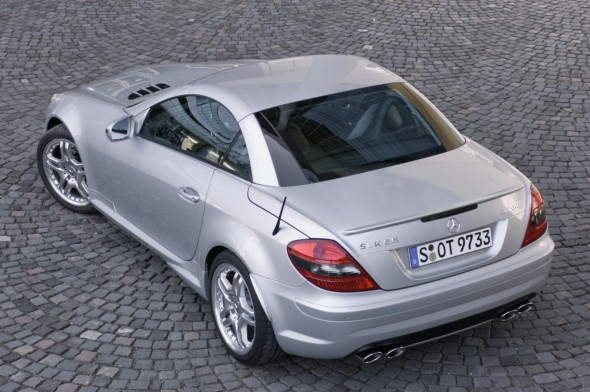
The swept-back A-pillars accentuate the dynamic silhouette of the Roadster. These continue the lines of the bonnet and transfer them to the rear end in a curve when the vario-roof is closed, the C-pillars dipping down gently into the boot lid and characterising its slightly curved form.
One might compare these flowing lines with a cord of muscle, too; it extends over both outer areas of the boot lid and gently transfers its strength down to the rear apron. This provides a visual separation from the spoiler lip, as it slightly raises the centre area of the boot lid, forms a horizontal line and contributes to the outstanding aerodynamics of the new SLK-Class.
Other styling features at the rear of the SLK-Class include two oval exhaust tailpipes in chrome, striking tail lights with LED technology and an integral, powerfully accentuated rear apron. These too emphasise the uncompromising athleticism of this unique automobile. In other words, the new SLK-Class cuts an impressive figure from any angle and viewpoint.
Interior: man and machine combined
This also applies to the interior. The aim was to transfer the dynamic and emotive design language of the exterior to the interior, thereby reinforcing the active character of the car. The result is a success: the interior design uncompromisingly follows the roadster philosophy and ensures a harmonious link between man and machine.
One finds out what this means in practice when getting into the new Mercedes sports car. The design of the dashboard is sporty and technically oriented, with a clear priority on practicality but without appearing cool or featureless.
The interesting colour contrast formed by the silver-coloured controls and the black surfaces on the steering wheel, centre console and transmission tunnel already conveys the distinctive design concept of the new SLK-Class. Here superior technology not only impresses by its reliable operation, but also by its sophisticated design.
It is particularly the cockpit that forms a focal point for a successful combination of form and function, technology and aesthetics: two large, clear dial instruments supply the driver with the most important information – vehicle speed, time, engine speed and fuel level.
When designing the dials the stylists followed the example of high-quality chronometers – one glance at the white needles is sufficient to give the driver precise information. Despite being highly functional this concept is special in stylistic terms.
This is ensured by the silver-painted tubes which surround each of the two dial instruments. Their elliptical faces are heavily slanted and inclined towards each other, providing the driver with an excellent view at all times. This is a fine example of ergonomics and aesthetics in perfect harmony.
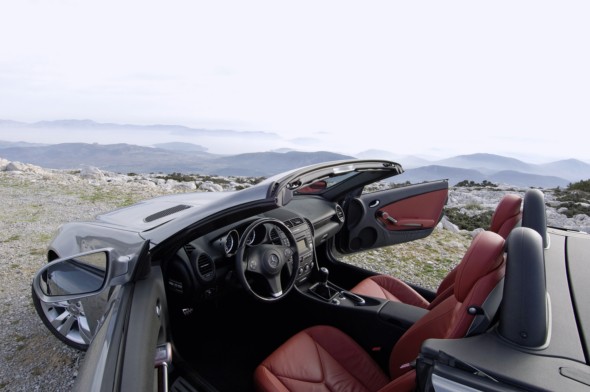
Dashboard: a bridge to the interior
With its embossed centre surfaces and semi-oval upper ventilation grille, the dash-board continues the design theme of the bonnet and transfers it to the interior with a flourish. The centre console and tunnel cladding extend these flowing lines to the rear wall of the passenger compartment.
A tasteful colour scheme and carefully selected materials perfect this all-round ambience. Depending on customer requirements the door linings in the SLK are in a two-tone design: when leather upholstery is specified, the centre panel, armrest and parts of the magnesium door handle share one of the interior colours.
The SLK-Class offers the most varied colour range in conjunction with leather upholstery. In this case SLK customers have a choice of six interior colours: black, universe blue, orient beige, dusky red, alpaca grey and the exclusive tobacco brown nappa leather.
The bodywork and vario-roof: expertise and skill
Designing an open-top sports car with the structural stability and safety standards of a saloon calls for tremendous expertise and a great deal of experience. Mercedes-Benz has both of these attributes and the new SLK-Class is further testimony to this.
The bodyshell delivers superlative results in terms of strength and rigidity, the essential key to delivering dynamic driving characteristics combined with optimum vibration damping and Mercedes standards of occupant safety. The figures speak for themselves:
- A measurement of the static bending strength on the body of the new SLK-Class reveals a 19 percent improvement with the roof down, when compared with its predecessor.
- Static torsional strength, an important indicator for the vibration characteristics of the body, outperforms the exemplary figures delivered by the previous SLK-Class by a remarkable 46 percent with the roof down.
When building the new SLK-Class, Mercedes engineers increased the proportion of high-tensile steel alloys to 42 percent of the total: these steels combine low weight with maximum strength, meaning that the great majority of components governing crash safety, strength and durability are now constructed from high-tensile sheet steel.
Long-term corrosion protection: fully galvanised body and more scratch-resistant paintwork
To equip the SLK with long-term corrosion protection, the entire bodyshell is galvanised. In addition, some of the metal panels are treated to an additional organic coating on both sides which also contains rust-inhibiting zinc pigments.
All the most vulnerable structural sections of the bodyshell are also protected with a cavity-fill preserving agent. A large area of the underbody is made from plastic so Mercedes engineers were able to dispense with conventional PVC underseal, a potential environmental hazard.
Instead, underbody cladding protects the bodyshell from stone chipping, wet and dirt. In keeping with all Mercedes passenger cars, the new SLK-Class is also protected by a 30-year MobiloLife warranty.
The new, more scratch-resistant clearcoat, too, is derived from the nano-technology sector, providing a new and enhanced level of scratch resistance and also enabling Mercedes-Benz to take another important step along the road towards improving the already excellent durability and value retention of the SLK-Class.
This innovative paintwork system has been in service at Mercedes-Benz since the end of 2003, and the company was the first automotive manufacturer in the world to adopt it. This paint protection system is standard on the new Roadster and is used with all the metallic and non-metallic paint colours for this vehicle.
The nano particles in the clear coat improve scratch resistance by a factor of three and ensure a long-lasting and visibly improved gloss sheen on the paintwork.
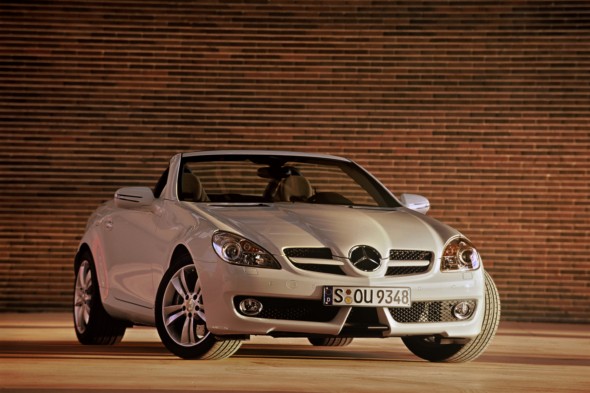
Vario-roof: new swivel mechanism creates more space in the boot
When it first appeared in 1996, the innovative vario-roof on the SLK-Class Roadster caused a sensation and set new trends in the construction of open-top cars. Mercedes-Benz has now developed this concept and has perfected the technology.
The folding hardtop in the new SLK-Class now opens and closes in just 22 seconds – three seconds faster than on the previous model. Moreover, the new SLK-Class offers even more luggage space in the boot when the vario-roof is retracted.
According to the VDA method, the boot of this car offers 208 litres of stowage volume, 63 litres more than on the previous model. This advance was achieved by a new and highly elaborate roof design, the crowning glory of which is a swivel-mounted rear window – not dissimilar to the one in the SL-Class of sports car.
This rotary movement ensures that the window nests firmly in the curved surface of the roof shell, restricting the capacity of the boot much less than in the previous model.
Aerodynamics: fine-tuning in the wind tunnel
Good design, high standards of road safety, superb aerodynamics – this combination is by no means always a given in the compact roadster market. However, it is a distinctive hallmark of the Mercedes-Benz SLK-Class. Starting from what was already a very high standard, Mercedes engineers have managed to achieve even more prog-ress with the new SLK-Class.
Although the wider and higher body shape and the new tyre sizes have increased the total frontal area of the car by four percent to 1.93 square metres, the Cd value or coefficient of drag used to express the aerodynamic properties of a body shape has been reduced by three percent, achieving a new level of 0.32. Here is a summary of the measurements:
| New SLK-Class* | Previous model* | |
| Coefficient of drag Cd | 0.32 | 0.33 |
| Frontal Area A m² | 1.93 | 1.85 |
| Wind resistance Cd x A m² | 0.62 | 0.61 |
*with vario-roof closed
The engineers in Sindelfingen used numerous aerodynamic details to achieve two things at once: they not only reduced the coefficient of drag, they also improved roadholding at high road speeds or when braking, thereby making an important contribution towards road safety.
This is demonstrated by the substantial improvements in lift forces over the previous model, with a reduction of about 30 percent on the front axle and 20 percent on the rear axle.
The windscreen wipers are another development from wind tunnel testing, which helps to explain why these are officially designated as “aero wipers”: instead of the jointed bracket system of conventional wiper blades, to which rubber wipers are attached, the aero wiper comprises a one-part rubber profile with integrated spoiler and two curved spring rails which precisely match the convex curve of the windscreen and which therefore always make contact at an optimum pressure.
Lights: projection-type headlamps employing halogen or bi-xenon technology
The headlamps on the new SLK-Class are not only very appealing in visual terms, they also satisfy the highest standards in terms of their technology. Mercedes-Benz has now replaced its reflection-type low-beam headlamps with a newly developed projection-type system, with H7 halogen bulbs mounted behind clear plastic lenses providing low-beam lighting.
Fog lamps with halogen bulbs are also included in the standard equipment of the new SLK-Class. They are housed in the bumper trim and, in conjunction with the optional bi-xenon headlamps, also offer a new cornering light function, providing lighting for the area ahead and to one side of the vehicle.
The advantage of this is that pedestrians and cyclists near the vehicle can be seen clearly, even at night. This cornering light function also enables drivers to orient themselves more effectively when cornering at low speed.
Whenever the bi-xenon headlamps are switched on, and up to a maximum speed of 40 km/h, the cornering light functions cuts in automatically in response to the driver using the turn signal indicator or turning the steering wheel by a corresponding angle.
At this point, the cornering light illuminates the area to one side of the vehicle through an angle of up to 65 degrees and a distance of up to 30 metres, thereby lighting up areas of the road which would normally not be visible with conventional headlamp technology.
Occupant protection: safety takes a front seat
Real-life safety – this tried-and-tested practical approach to safety as applied by Mercedes-Benz has been reinforced and thereby consistently honed over the course of recent years by a series of groundbreaking new developments from the Stuttgart-based vehicle brand’s engineers.
The new SLK-Class reaps the benefits of the progress that has been made: the safety technology on board the sporty roadster is in line with the very latest findings from the field of accident research, and sets new benchmark standards for this vehicle segment.
The Mercedes concept centres around restraint systems capable of adapting to different types of collision. The result is a further decrease in the loads placed on occu-pants in the event of a severe collision, as well as optimisation of the protective functions triggered following more moderate collisions.
It is in this key aspect that the new SLK Roadster differs noticeably from its predecessor, which was itself deemed to be one of the safest sports cars on the road. On the new model, both the driver and passenger airbags feature two-stage operation, as do the new two-seater’s belt force limiters.
This means that the systems are deployed in such a way that they are able to offer the greatest possible protection for the situation at hand.
The driver’s airbag is fitted with a two-stage gas generator: in the event of a minor impact at the front, the control unit only ignites the first stage and the airbag inflates more gently. Should the control unit detect a severe frontal collision, however, it deploys the second stage of the gas generator after a delay of some 5 to 15 milliseconds.
As a result, the airbag inflates at a higher pressure to provide the driver with the level of protection required in a collision of this severity. The airbag on the passenger side operates on precisely the same principle, as well as incorporating brand new technology which further improves the way in which the airbag inflates evenly to cover a wide area.
In addition to this, the initial pressure increase of the two-stage generator is reduced, meaning that the airbag inflates even more gently. This shows just how much consideration Mercedes engineers have given to the fact that children are often seated in the front passenger seat, where the newly developed airbag now offers them even more protection.
The belt force limiters, which make up part of the standard specification of the new SLK-Class, are also able to adapt to the severity of the collision. Should the control module detect a high impact load, it will reduce the restraining force acting on the belt strap after just a short time; as a result, more of the seat belt strap will be fed out and the airbag will be able to cushion the seat occupant more effectively.
Head/thorax airbag: new air cushion integrated into the seat backrest
Mercedes-Benz is also equipping the new SLK-Class as standard with the newly developed head/thorax sidebags which have already debuted in the top-of-the-range SL-Class sports cars. They are accommodated in the backrests of the seats where they are positioned between the sturdy magnesium frame and the cushion holder.
Following a side impact, the head/thorax airbag transforms into an asymmetrically shaped cushion in a matter of just 30 milliseconds, with the top edge reaching high above the seat when the airbag is fully inflated. This reduces the risk of the occupant’s head colliding with either the side window or any objects that penetrate the interior of the vehicle, regardless of the occupant’s seating position.
The new SLK-Class is also equipped as standard by Mercedes-Benz with a roll-over sensor, which reliably recognises this type of accident and relays its data to the restraint systems’ central control module. In response to this signal, the micro-computer activates the belt tensioners and the head/thorax sidebags in the SLK seats, regardless of whether the vario-roof is open or closed.

Bodyshell structure: larger crumple zones at the front end
The bodyshell structure of the new SLK-Class also offers occupants even greater safety reserves than the predecessor model. The crumple zones in the front end, which absorb energy in the event of a frontal collision, have now been enlarged and the flow of forces optimised in order to offer even better protection for the passenger cell.
This fact is clearly demonstrated by the results of numerous crash tests which the new Roadster successfully completed as part of a development process that lasted several years.
Key features of the structure at the front end include straight front side members and the twin-wall front cross member. These elements form a sturdy composite assembly, so that in the event of a frontal collision where a load is exerted on one side only at the front end (offset impact), the opposing side is also able to absorb some of the energy.
Mercedes-Benz engineers have also developed a second side member level which is positioned above the wheel arches and front wheels and has been specifically designed to enhance occupant protection in the event of an offset crash at the front. The passenger cell of the new SLK-Class is built on a sturdy floor assembly with an inserted transmission tunnel made from thick-walled steel, plus an additional locking plate.
Straight support sections running underneath the body on both sides link the front end’s side members with the rear-end structure. Lateral reinforcement for the floor is provided in the form of two solid supports underneath each seat.
Roll-over protection: sturdy tubular reinforcements in the A-pillars
Engineers at Mercedes also devoted a great deal of attention to roll-over protection in the new SLK-Class. In addition to the characteristic roll-over bars behind the seats, roll-over protection also comes in the form of a high-strength, A-pillar composite structure.
At the core of this assembly are two oval pipes made from heat-formed, high-strength steel, which are welded together with the A-pillar’s metal walls and extend up to the top of the windscreen frame. These complement the protective effect of the roll-over bars and ensure that the passengers’ survival space remains as intact as possible should the vehicle roll over.
AIRSCARF: an invisible scarf
Longer and more– that’s the message sent out by the new SLK-Class to aficionados of open-top motoring. It means that even more trips can be made with the vario-roof down and that the open-air motoring season stretches into the colder times of the year courtesy of the sensational, sporty Mercedes Roadster.
It is all thanks to a revolutionary new neck-level heating system for both driver and passenger which is now available as an option. AIRSCARF is the name given by the Mercedes engineers to their world first. It works as follows: warm air which is emitted from special vents in the head restraints at the touch of a button acts as an invisible scarf by flowing around the neck, throat and head of the SLK’s occupants.
The heating element measures only a few centimetres in size, allowing it to fit into the backrest of the SLK seat. It consists of a number of rectangular ceramic elements with a total heat output of around 216 watts. The heat produced is dissipated into the air through aluminium fins which are positioned between the individual ceramic elements.
A blower directs the air though a plastic duct until it reaches the head restraint where it flows out of a special vent to warm up the neck, throat and head of the seat occupant.
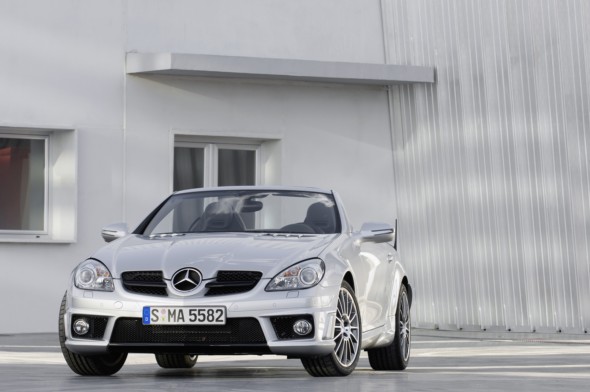
AIRSCARF comes equipped with a three-speed switch and an electronic control module that adjusts heating at neck level to meet current requirements. A data bus keeps the micro-computer in contact with the speedometer, the temperature sensor in the centre console and the exterior thermometer of the Mercedes Roadster. The micro-computer then compares this up-to-the-minute data with the stored characteristic curves for particular ambient conditions and driving situations.
Pushing a button starts the system in switch position 3, after which it adjusts automatically depending on ambient temperature and road speed. The AIRSCARF system adapts the blower speed constantly in order to achieve optimal distribution of the warm air in all situa-tions. This adaptive control based on stored characteristic data is active up to a speed of 120 km/h. At higher speeds, the system operates at a constant setting.
Sports seats: newly developed design with rigid magnesium frame
As well as the AIRSCARF, the seat experts at the Mercedes-Benz Technology Centre (MTC) worked on the development of further special technical features which are geared towards boosting ride comfort and increasing practicality.
The sports seats boast a number of distinguishing features, including core springing and a layer of foam which provides a precise level of cushioning. Both of these elements – the core springs and the layer of foam – are incorporated into a robust cushion shell made from fibre-reinforced plastic.
When it came to the seat backrests, the engineers opted for magnesium. By combining low weight with high strength, this high-tech material helps to boost occupant safety by providing extra lateral bracing for the side wall in the event of a side-on collision, for example. In addition to this, the silver-painted magnesium frame provides a solid basis for attaching the standard head/thorax sidebags.
Dimensional concept: extra room for driver and passenger alike
The revolutionary new AIRSCARF system, sports seats which are also ideally suited for longer journeys, the broad scope of adjustment for individual seat positioning and the seats’ increased fore-and-aft adjustment range all clearly demonstrate just how much progress has been made in the new SLK-Class when it comes to comfort and convenience compared to the previous model.
The increase in the exterior body dimensions plays a crucial role in this respect, as the car’s passengers also benefit from the additional length (+ 72 millimetres), width (+ 65 millimetres), height (+ 20 millimetres) and wheelbase length (+ 30 millimetres).
The extra interior space means that passengers enjoy higher levels of comfort compared to the previous Roadster model. The width at shoulder height, one of the key criteria for assessing interior comfort, now measures 1326 millimetres, representing an increase of 13 millimetres compared to before.
The greater overall height of the body translates into 965 millimetres of headroom for the vehicle’s occupants, an extra 16 millimetres compared to the model it replaces.
Climate control: three systems available to choose from
Progress has also been made in terms of climate comfort in the new SLK-Class. There are now a total of three systems to choose from:
Even the standard heating and ventilation system fitted by Mercedes-Benz, the automatic heating system, boasts an array of sophisticated microelectronics. The automatic heating system employs sensors which permanently monitor the temperature inside the car and maintain the temperature constantly at the settings selected by the driver and passenger.
THERMATIC represents a practical extension to the automatic heating system. Although the basic heating and ventilation system is equipped with sensors and an electronic control for maintaining the desired interior temperature at a constant level, this system reaches its limits during the hot summer months as it lacks the necessary refrigeration unit.
This gave rise to the development of the THERMATIC system that is fitted as standard on SLK 350 and SLK 55 AMG models. This system cools down the air flowing into the car from the outside whilst also removing any moisture.
THERMOTRONIC represents the very ultimate in climate control for the new SLK-Class, and offers S-Class standards of climate comfort in a sports car. The scope of functions includes automatically regulating the temperature separately for the driver and passenger sides, as well as using additional sensor signals regarding air humidity, ambient temperature, pollutant levels and solar radiation.
Car radios: high-tech information and communications technology
Mercedes-Benz offers three state-of-the-art units to keep the SLK’s passengers both informed and entertained. As well as being able to receive radio stations and play CDs, each is also able to serve as a command centre for a mobile phone. Apart from this, a great many of the functions can be controlled using the keys in the multifunction steering wheel, meaning that motorists do not need to take their hands off the wheel.
The Audio 20 CD unit features an FM/MW/LW receiver and allows up to ten station presets to be stored per waveband. The unit’s four-channel amplifier produces an output of 4 x 25 watts. The integral CD player is also capable of playing CDs which have been burned at home.
Further features of this unit include automatic station search, RDS Radio Data System (for FM stations) and a station scan function.
The Audio 50 APS offered for the SLK-Class by Mercedes-Benz is a powerful system which combines a twin-tuner FM receiver, CD drive as well as an arrow-based navigation system with dynamic route guidance based on RDS-TMC into a single unit.
Information appears on a 4.9-inch colour display with graphics capability. The road network of the main European countries is stored on the navigation CD, while the integral CD drive is also capable of playing music CDs whilst the navigation function is activated.
The sophisticated COMAND APS control and display system, which has already proved extremely successful in top-of-the-range Mercedes-Benz models, is now to be made available for the SLK-Class for the first time. Boasting the latest TFT tech-nology, the large, 6.5-inch colour display offers outstanding brilliancy and colour re-production, whilst the 16:9 picture format is also suitable for watching films. DVD videos, as well as audio and MP3 CDs can all be played in the DVD player.
SLK passengers are also able to read SMS text messages on the COMAND screen and reply to them using the unit’s control keys.
New SLK-Class models which are factory-fitted with one of the three available radio units come equipped with a total of nine speakers: three in each door, a centre-fill speaker in the top section of the dashboard, plus two speakers in the rear.
An even more effective acoustic experience is available by opting for the newly developed multi-channel sound system. With a maximum output of 380 watts, this system is harmonised perfectly with the acoustic conditions in the interior of the SLK.
A micro-phone inside the car detects current noise levels, allowing the micro-computer to precisely adjust volume and sound, even with the vario-roof down. The result is sheer listening pleasure at all times. The surround effect is achieved using two extra speakers which are positioned above the stowage compartment on the rear wall.
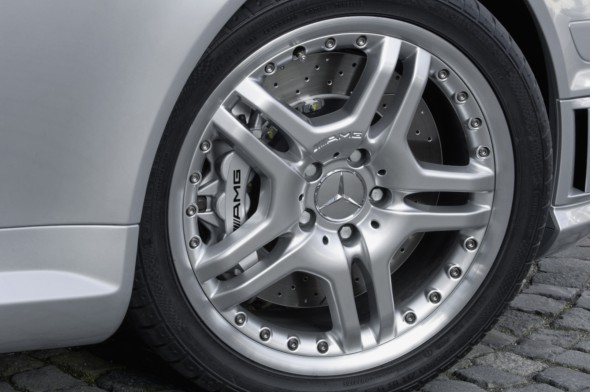
Engines and transmissions: geared up for power
With AIRSCARF, COMAND, a vario-roof and head/thorax side airbags, the new SLK Roadster is a remarkable car whichever way you look at it, packed with innovations no other vehicle in its class can match. The range of engines available for the new SLK is also outstanding.
Customers can select from a choice of three petrol-engined variants developing between 120 kW/163 hp and 265 kW/360 hp and including – for the first time in this vehicle class – an eight-cylinder unit from the Mercedes-AMG stable.
The V6 engine in the SLK 350 is a totally new development boasting all the qualities you look for in a powerful, free-revving sports roadster engine. No other power unit in this displacement class can match the new six-cylinder unit when it comes to output and torque characteristics aimed firmly at enhancing driving dynamics and the overall motoring experience. Added to which, the V6 newcomer also sets the pace in terms of fuel economy, exhaust emissions and comfort.
The six-cylinder powerplant develops 200 kW/272 hp at 6000 rpm from a displacement of 3498 cc. That equates with an output of just 57 kW/78 hp per litre which raises many an eyebrow in this displacement class.
Torque levels are equally as exceptional, with 350 Newton metres available as low down as 2400 rpm and remaining constant up to 5000 rpm. That guarantees exceptional pulling power and rapid mid-range accel-eration, but also relaxed driving in high gears. With the vario-roof down and an open road ahead of them, roadster fans could not ask for more.
NEDC combined consumption of 10.6 litres per 100 kilometres is further evidence of the state-of-the-art technology at work inside the V6 engine. Teamed up with the 7G-TRONIC seven-speed automatic transmission, the new power unit burns just 10.1 litres of fuel per 100 kilometres (NEDC combined consumption).
This makes the SLK 350 some three percent more economical than the outgoing SLK six-cylinder model with automatic transmission, even though it can point to 25 percent greater output.
By incorporating the four-valve technology and four overhead camshafts which are now staple ingredients of sports car engines, the Stuttgart-based engineers had already laid the foundations for exceptional power development.
However, they refused to stop there, broadening their horizons to include a system which allows the interaction of the 24 valves to be controlled as required according to the engine load, thereby en-suring an ultra-fast charge cycle in the cylinders: continuous camshaft adjustment. The angles of the intake and exhaust camshafts can each be continuously adjusted by 40 degrees, allowing the valves to open or close at the optimum moment in any driving situation.
The key features of the intake module in the Mercedes six-cylinder engine are elec-tropneumatically driven flaps at the end of each intake port which make a significant contribution to enhancing fuel economy. Mercedes engineers refer to these as “tum-ble flaps”, a term which describes their role in causing the fuel/air mixture literally to tumble.
This increases the turbulence of the airflow, which consequently enters the combustion chambers at greater speed and spreads out evenly. The end result is improved combustion.
In addition to outstanding output and torque characteristics, impressive fuel economy and low vibrations, the new V6 engine also boasts certain audible benefits. As part of an exhaustive programme of testing, Mercedes engineers took acoustic measurements from almost all of the engine’s 210 separate parts – from the crankcase to the engine mounts, the pistons and the injection valves – and assessed their noise output levels and frequency.
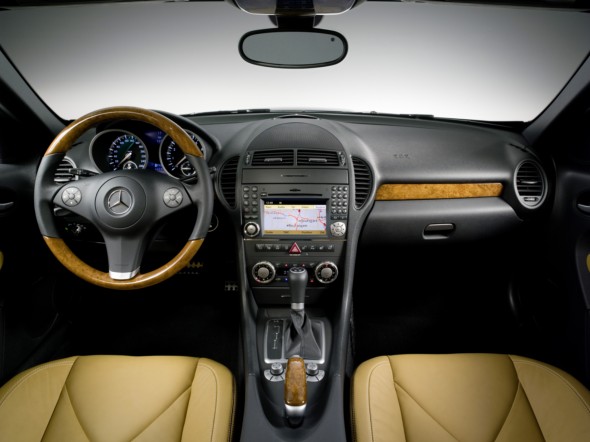
Noise configuration is developing into one of the key areas of engine development. Here, the engineers are faced with the challenge of keeping drive-past noise suppressed whilst shaping a pleasant and sonorous engine sound. To this end, the experts charged with creating the six-cylinder unit for the SLK-Class adopted an approach focusing on reducing noise while improving sound.
A series of measures were developed with the aim of restricting engine noise, from a two-cartridge air filter with integral resonators to a sound-absorbent mat under the bonnet. At the same time, the sound specialists channelled their efforts into creating sports car vocals for the SLK-Class. They achieved this by emphasising certain frequencies, predominantly through careful configuration of the twin-pipe exhaust system.
The four-cylinder engine: TWINPULSE technology brings an eight-percent improvement in fuel economy
Also making its debut in the SLK-Class is the state-of-the-art four-cylinder engine developing 120 kW/163 hp, a member of the new generation of TWINPULSE power units.
This engine type combines various technologies – such as supercharging, charge air cooling, four-valve technology, variably adjustable camshafts and Lanchester balancer shafts – which push driving pleasure and smoothness to the maximum and keep fuel consumption to a minimum.
This cutting-edge package allows the new SLK 200 KOMPRESSOR to get by on eight percent less fuel than its predecessor of the same power output. NEDC combined consumption stands at 8.7 litres per 100 kilometres.
In the four-cylinder SLK, a supercharger with charge air cooling provides the muscle underpinning the agility and dynamism you look for in a sports car. This means that high levels of torque can even be called on at idling speed, in turn allowing a longer overall ratio. The new engines are thus impressively lean-running – i.e. extremely economical. Further enhanced performance and further reduced fuel consumption form the essence of TWINPULSE engines.
The key engine and performance statistics for the new SLK-Class are as follows:
| SLK 200 KOMPRESSOR | SLK 350 | SLK 55 AMG | |
| Cylinders/ arrangement | 4/in-line | 6/V | 8/V |
| Displacement | 1796 cc | 3498 cc | 5439 cc |
| Output | 120 kW/163 hp | 200 kW/272 hp | 265 kW/360 hp |
| Max. torque at | 240 Nm/ 3000–4000 rpm | 350 Nm/ 2400-5000 rpm | 510 Nm/ 4000 rpm |
| 0–100 km/h | 7.9 s (8.3 s*) | 5.6 s (5.5 s**) | 4.9 s** |
| 60–120 km/h | 12.2 s (8.3 s*) | 8.7 s (5.1 s**) | 3.8 s** |
| Max. speed | 230 km/h (226 km/h*) | 250 km/h | 250 km/h |
| Fuel consumption*** | 8.7 l/100 km (8.8 l/100 km*) | 10.6 l/100 km (10.1 l/100 km**) | 12.0 l/100 km**/2 |
*with five-speed automatic; ** with seven-speed automatic; ***NEDC combined consumption; ²provisional value
Transmissions: five, six and seven-speed variants available
Mercedes engineers have further improved the six-speed manual transmission fitted as standard in the SLK 200 KOMPRESSOR and SLK 350 and given it an even sportier edge.
The key to these improvements is a single-rod gearshift system, which allows drivers to make fast, sporty gear changes, whilst at the same time offering even greater shifting comfort thanks to the use of sophisticated damping elements.
The SLK 200 KOMPRESSOR is optionally available with the proven five-speed automatic transmission, while the SLK 350 can be supplied with the innovative 7G-TRONIC, the world’s first seven-speed automatic transmission for passenger cars.
The 7G-TRONIC is brimming with technical innovations which ensure more powerful acceleration, extra-fast mid-range sprints, lower fuel consumption and a higher level of shift comfort. This transmission is standard on the SLK 55 AMG.
In keeping with the dynamic and agile character of the new SLK-Class, drivers can operate both the five-speed and seven-speed automatic transmissions using gearshift buttons on the steering wheel (optional). Plus, they can limit the gear stages or select a new gear manually, allowing them to fully exploit the engines’ extensive power reserves in any driving situation.
And they always have the option, of course, of switching to “M” (Manual) mode at the touch of a button on the tunnel trim. The gear currently selected is highlighted in the central display of the instrument cluster.
The chassis: leading the pack
Vibrant dynamism, light-footed motoring pleasure, maximum safety – three hallmark characteristics of the SLK-Class which are moulded to a great degree by the Roadster’s chassis. The axles, steering and brakes have all been developed anew or redeveloped by the Mercedes engineers in an effort to surpass even the high standards set by the model it replaces.
The advances that have been achieved make their presence felt within the first few miles and help create the inimitable motoring experience – above all thanks to the sporty handling, high-precision steering, excellent ride comfort, sure handling right up to the car’s limits and exemplary braking stability.
The previous double-wishbone front suspension with recirculating-ball steering has now been superseded by a three-link axle featuring McPherson spring struts and a rack-and-pinion steering system. The spring struts consist of coil springs, twin-tube, gas-filled shock absorbers and compact head bearings.
The standard-fit anti-roll bar is linked to the spring struts by means of a torsion-bar linkage, with rebound buffer springs being used to boost the effect of the anti-roll bar when the vehicle is corner-ing at speed.
There were a number of good reasons for switching to the new steering system. The most pressing argument was the more direct response offered by rack-and-pinion steering which helps underline the dynamic, sporty credentials of the new SLK-Class. The steering continues to be power-assisted to reduce the effort required to turn the wheel.
Making its debut in the SLK-Class, however, is the speed-sensitive steering which is available as an option, and which is even smoother and more closely geared towards the driver’s needs. It is designed to reduce steering torque in relation to the current road speed by up to 50 percent.
The multi-link independent rear suspension which has already proved so successful in the past will continue to be fitted on the new SLK-Class where it combines with the newly developed front axle, the extended wheelbase and the standard-specification ESP® Electronic Stability Program to deliver a high degree of handling safety, dynamism and passenger comfort.
Suspension and damping of the rear wheels is the task of coil springs working together with single-tube, gas-filled shock absorbers.
Drivers with a passion for sporty motoring can opt for the SLK-Class chassis to be given firmer suspension and damping settings. With the sports chassis fitted, the body is lowered by ten millimetres at the front and the rear. In this sportier set-up, total spring travel at both axles is shortened by ten millimetres compared to the standard chassis, while the spring rates increase by as much as ten percent.
Brakes: state-of-the-art technology for maximising safety
Mercedes engineers have once again made tremendous progress in the field of braking technology too, particularly when it comes to braking performance and smoothness. Each of the different models in the range comes off the assembly line complete with internally ventilated disc brakes measuring between 288 and 340 millimetres in diameter, depending on the model in question.
The SLK 350 is equipped with a state-of-the-art, lightweight braking system including perforated front brake discs. The perforations are an efficient means of dispelling dirt and water, meaning that the brakes continue to deliver excellent stopping power in inclement weather conditions.
The cover plates underwent development in the wind tunnel: they have been styled in such a way that the airstream flows from the inside outwards to keep the brake discs free of spray water. At the same time, cooling of the brake discs and the wheel bearings has also been enhanced.
Reliable deceleration at the rear of the new SLK-Class comes in the form of solid disc brakes. The fixed-calliper brakes used here by Mercedes-Benz feature twin-piston technology.
Control systems: ESP® with warning function to indicate low tyre pressure (optional)
The new SLK-Class, like all Mercedes-Benz passenger cars, is equipped as standard with the most advanced and most efficient driving safety systems in the world. They reduce the risk of skidding when cornering, keep the sports Roadster safely on course when braking, make pulling away on a slippery surface easier and shorten the braking distance in emergency situations.
ESP®, the Electronic Stability Program, is at the heart of all dynamic handling control systems; In the new version of the Mercedes-Benz Roadster, ESP® is also able to offer a further function as an option which warns drivers of a loss of pressure in the tyres.
ESP® constantly monitors the rotation speed of the wheels, which depends mainly on road speed, the vehicle load and the air pressure in the tyres. It is able to detect any significant deviations in the readings. If the system detects that pressure is being lost in any of the tyres, a red warning appears in the cockpit’s central display which reads “Tyre pressure, check tyres.”
Wheels and tyres: extensive factory-fitted range to choose from
The SLK 200 KOMPRESSOR is shod as standard with 205/55 R 16 wide-base tyres and 16-inch light-alloy wheels sporting an attractive seven-spoke design. The six-cylinder SLK 350 model comes with 17-inch wheels featuring an even sportier five-spoke design, and is fitted with wider tyres at the rear (245/40 R 17) than at the front (225/45 R 17). The following wheels and tyres are fitted as standard:
| SLK 200 KOMPRESSOR | SLK 350 | SLK 55 AMG | |
| Front | Tyres 205/55 R 16 Wheels 7 J x 16 ET 34 | Tyres 225/45 R 17 Wheels 7.5 J x 17 ET 36 | Tyres 225/40 R 18 Wheels 7.5 J x 18 ET 37 |
| Rear | Tyres 205/55 R 16 Wheels 7 J x 16 ET 34 | Tyres 245/40 R 17 Wheels 8.5 J x 17 ET 30 | Tyres 245/35 R 18 Wheels 8.5 J x 18 ET 30 |























































































































































































































